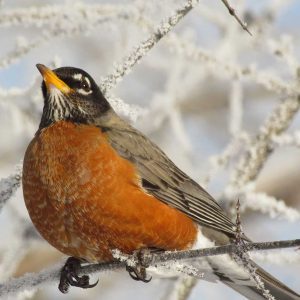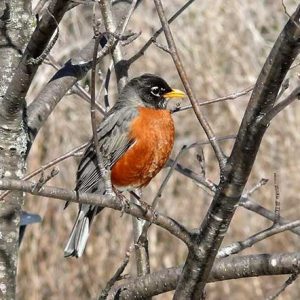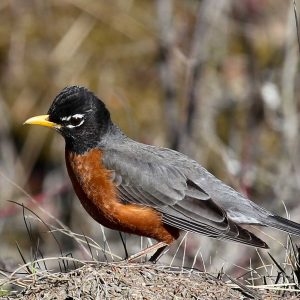
American Robin in Winslow, by Tina Richard
Before the big spring snow, on a recent morning walk around our neighborhood with our dog, Loki, spring seemed to have arrived overnight. “Pip-pip-pip”—the calls of American Robins seemed to sound from every yard. The lawns were just starting to regain some green among winter’s leftover brown matted grass but the robins didn’t care. They were standing here and there and everywhere, their famously red breasts puffed out as if they felt proud to be declaring their residency.
Despite the snow storm, the robins are still here, dawdling about, unthwarted by the quickly melting white blanket (robins are, after all, “half-hardies”—a term we birders use to describe species that typically winter farther south but some of which hang around through the winter). And that was definitely the case this year. We saw several small flocks around Gardiner and elsewhere most of the winter long.
Robins are among the most abundant nesting inhabitants throughout most of suburban U.S. and southern Canada. They are well-known and well-loved even by people who don’t know many other birds. How can you not know this bird that hops around on lawns in plain sight, sings loudly from the tops of garages and telephone poles, and nests in the shrubbery we use to landscape around our homes?

Robin in Wilton, by Tony Nazar
We’ve found thought, that many people are surprised to learn that American Robins also nest across natural landscapes. These include vast expanses such as the northern Boreal Forest region of Canada and Alaska where suburbia and lawns are replaced by millions of acres of forests and peatlands. The robin’s beautiful song, echoing out across remote valleys and lakeshores, are a distinctive feature of the soundscapes of such wild places, just as they are for suburban neighborhoods farther south.
The name of our familiar American Robin came from the early European settlers who, after a difficult voyage of months on the sea, arrived on what we now call North America probably looking for connections to where they had come from. A very familiar and comforting species from England (and across Europe) was a red-breasted bird of gardens and yards that they knew as the Robin. Today we refer to that species as the European Robin in order to differentiate it not only from the American Robin, but from the many other birds around the world that now also bear the name “robin.”

American Robin in Sunkhaze Meadow National Wildlife Refuge, by David Small
Wherever they ended up in the world, the British, in particular, seemed to often want to remember the birds back home. There are now unrelated birds called robins or that have “robin” as part of the name (like the robin-chat or magpie-robin) in Australia, New Zealand, Africa, and Asia.
The bird we know here in North America had many names in the Indigenous languages of the peoples that had been here for millennia. Some of the names are (or are thought to be) based on sounds the birds make. Some imitate the songs; others the calls. Still other Indigenous names describe something else about the bird. Some called the bird a name meaning “the whistle maker” or “one who whistles.” And another as “the bird that is good at digging.”
One name we really like is what one source described as the Mi’kmaq (sometimes spelled in other ways) word, “nikchipkudaagedoo,” which was said to mean “leaf rattler.” What a great way to describe the way the birds we know as robins dig around in the leaves as they search for food, something we see every day now!
— Allison and Jeff Wells
Banner photo: American Robin by Jeff Wells









What are Robins eating when the ground is frozen or covered with snow?
Good question, Charlie! Often times, if the ground isn’t frozen, they can get at items in the ground under the snow. They also eat fruits and berries that have remained on trees and bushes from the fall.